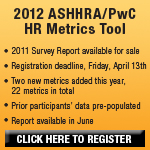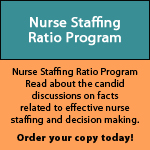ASHHRA eNews Pulse
ASHHRA
ASHHRA e-News Brief: April 2012Leading People Through Change is the theme of this year’s ASHHRA conference in Denver, September 22–25. As you know, leading people through change isn’t easy to do, but as your president, and with the ASHHRA board, we want to help you do it. In January, I wrote about opportunity and the beginning of a new year that lets us reinvent ourselves and our work. In February, I wrote about volunteerism and the wonderful work done by our board and committee volunteers. Last month, I wrote about thanking our own HR teams by celebrating Health Care HR week. This month, I want to share a little about ASHHRA and how we make decisions that help meet your needs as members of ASHHRA. It all begins with our strategic plan.
Strategically, ASHHRA is here to advance "The Human Side of Healthcare." This means helping each of you, our members, become more effective, valued, and credible leaders for your organizations and in the field of health care human resources. This is guided by both the ASHHRA values and strategies that provide the foundation for what we do, for the programs that we offer, and for the committee work that is accomplished throughout the year.
Our values will probably resonate with you. They are very similar to the values established by many health care organizations that we serve and they have been our foundation for 48 years. They are: People... Integrity...Leadership...Diversity...Collaboration...Excellence... Innovation.
The ASHHRA strategies were established in 2010. They are: be the first choice for health care HR knowledge; be a trusted and dependable source; link a diverse and expansive health care community; and be the leader in health care HR workforce policy, advocacy, and best practices.
Why an annual conference and webinars? We want to be your first choice for health care HR knowledge. Why the ASHHRA Concierge Service? Our goal is to be the most trusted and dependable source of health care HR data for you and your leadership as well as for your health care organization. How do we link a diverse and expansive health care community? We have partnerships with best practice organizations that support us through whitepapers, education, grants and scholarships, and sponsorship of initiatives. What do the Regional, Chapter, and Member Services; Learning and Education; Advocacy; and Annual Conference committees offer that relate to our strategies? They offer the opportunity to be the leaders in health care HR workforce policy, advocacy, and best practices.
Over the next several newsletters I will share a little bit about the ASHHRA board members and how they model the ASHHRA values and embed the strategy in every decision they make and every project we embark upon. I know you will be amazed at the amount of work these volunteers do and what they’ve been able to accomplish as they Lead People Through Change.
Irma L. Pye, SPHR
ASHHRA 2012 President
Senior Vice President & CHRO
Valley Baptist Health System
Harlingen, Texas
Visit http://www.ashhra.org/learning/webinars.shtml#041712 to view the full article online.
Visit http://www.ashhra.org/conference/2012/registration.shtml to view the full article online.
Visit http://www.ashhra.org/resources/labor_activity.shtml to view the full article online.
SOURCE: THE BOSTON GLOBE
Visit http://articles.boston.com/2012-03-24/health-wellness/31237407_1_alarms-medical-devices-maisel to view the full article online.
SOURCE: HEALTHLEADERS MEDIA
Visit http://www.healthleadersmedia.com/page-1/LED-278683/Healthcare-Job-Growth-Slows-in-March-but-Q1-Strong to view the full article online.
SOURCE: THE NEW YORK TIMES
Visit http://www.nytimes.com/2012/03/22/your-money/displaced-men-trade-blue-collar-jobs-for-nursing.html?_r=2&pagewanted=1&sq=health%20insurance&st=cse&scp=5 to view the full article online.
SOURCE: HOSPITALS & HEALTH NETWORKS
Visit http://www.hhnmag.com/hhnmag/HHNDaily/HHNDailyDisplay.dhtml?id=1870004509 to view the full article online.
SOURCE: BECKER’S HOSPITAL REVIEW
Visit http://www.beckershospitalreview.com/compensation-issues/how-do-chief-nursing-officer-salaries-differ-by-hospital-bed-size.html to view the full article online.
SOURCE: BECKER’S HOSPITAL REVIEW
Visit http://www.beckershospitalreview.com/compensation-issues/compensation-manifesto-11-steps-for-hospital-ceos-and-compensation-committees-to-qget-it-rightq.html to view the full article online.
SOURCE: BECKER’S HOSPITAL REVIEW
Visit http://www.beckershospitalreview.com/hospital-management-administration/employee-engagement-no-longer-a-qsoftq-science-3-steps-to-cultivate-more-committed-employees.html to view the full article online.
SOURCE: BECKER’S HOSPITAL REVIEW
Visit http://www.beckershospitalreview.com/hospital-management-administration/chuck-lauer-10-factors-in-creating-a-positive-work-environment.html to view the full article online.
SOURCE: AMEDNEWS
Visit http://www.ama-assn.org/amednews/2012/04/02/prsa0402.htm to view the full article online.
SOURCE: CHICAGO SUN-TIMES
Visit http://www.suntimes.com/lifestyles/health/11557385-423/when-is-it-ok-for-a-doctor-to-hug-a-patient.html to view the full article online.
SOURCE: THE NEWS JOURNAL OF WILMINGTON, DEL.
Visit http://www.kitsapsun.com/news/2012/mar/24/hospitals-strive-to-be-more-congenial/ to view the full article online.
SOURCE: ABC NEWS
Visit http://abcnews.go.com/Health/hospitals-home-making-medical-stays-stressful-patients/story?id=16082673#.T4Lnjdnhd5I to view the full article online.
SOURCE: FIERCE HEALTHCARE
Visit http://www.fiercehealthcare.com/story/docs-nurses-take-lead-healthcare-collaboration/2012-04-05 to view the full article online.
SOURCE: HOSPITALS & HEALTH NETWORKS
Visit http://www.hhnmag.com/hhnmag_app/jsp/articledisplay.jsp?dcrpath=HHNMAG/Article/data/03MAR2012/0312HHN_FEA_boardroom&domain=HHNMAG to view the full article online.










